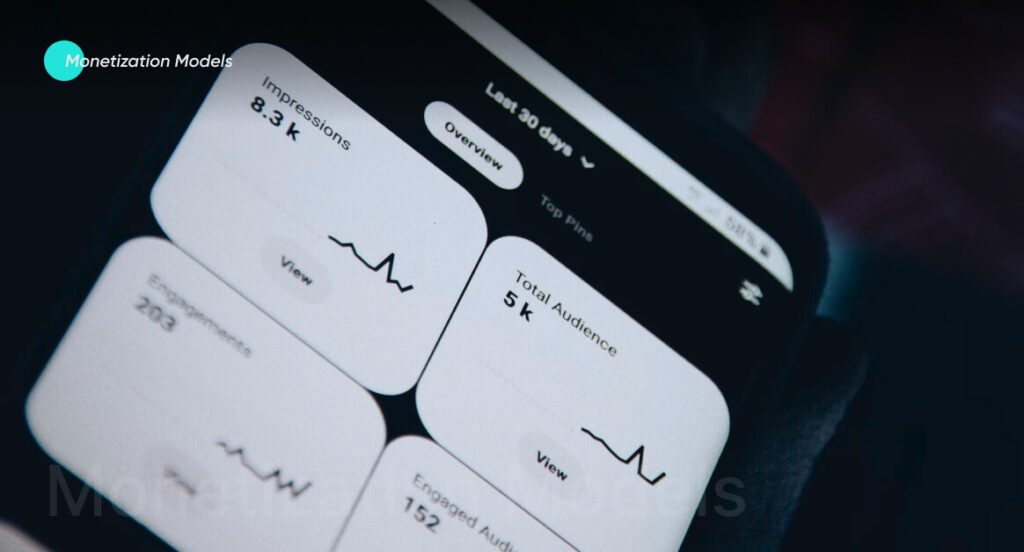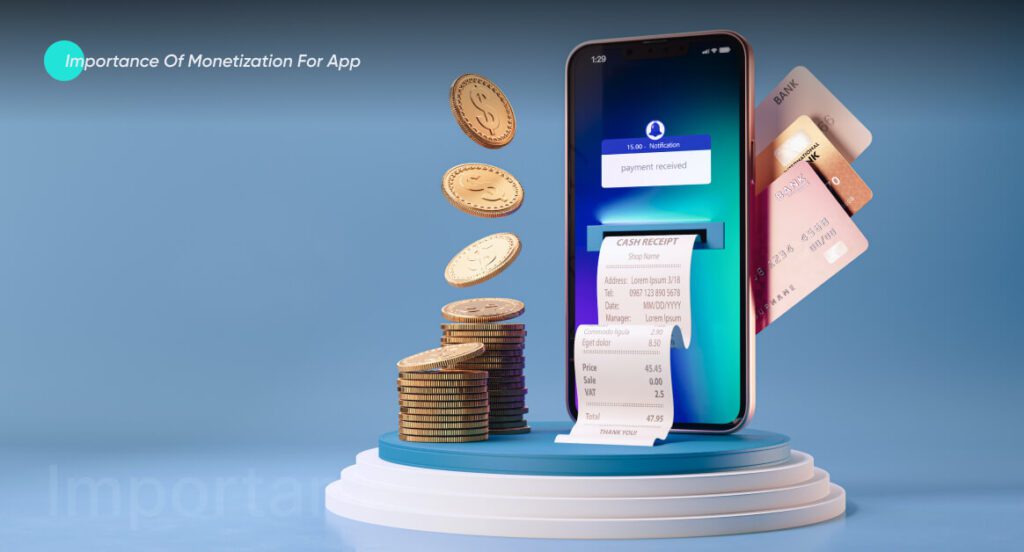How Much Money Do Apps Make?
Mobile apps can potentially bring in millions of dollars for businesses, both in revenue and consumer spending on the app. With the industry expected to touch the Trillion-dollar mark, it’s no wonder that thousands of entrepreneurs are tapping it.
However, converting this potential into actual returns isn’t as easy as it seems. With over 2.87 million apps on Google Play and 2.18 million apps on the App Store , the competition is the toughest it’s ever been. Many entrepreneurs face the nightmare of defunct apps within two years after launching them because of using the wrong revenue model. It’s important to choose the right one to ensure longevity and success.
In this blog, we will give you a comprehensive rundown of the preliminary steps in determining the right revenue model, monetization models you can choose from, and tips to choose the best model.
So, let’s dive in!
What To Consider Before Making a Money-Making App
Entrepreneurs need to consider several different factors when creating a money-making app. In this section, we’ve mentioned some of the preliminary considerations:

1. Purpose of the App
Before you choose the monetization model for your application, you need to understand the app’s purpose and what categories it falls into. Ask yourself these questions:
- What issues does my application tackle?
- How does it tackle these issues?
- What impact would my app have on the industry?
- How will the app cater to user needs?
The app’s purpose lays the foundation of the application and decides whether the app will stay in the race. The clearer you are about your app’s purpose, the more probable you’ll make the right decision regarding the revenue model.
2. Target Market
When making money from mobile apps, it’s important to consider your target audience and their needs. If your app targets business people, it’s crucial to have a monetization strategy that doesn’t waste their time. On the other hand, if your app is for kids, it’s best to offer some features for free.
To successfully earn an income from your app, it’s essential to understand your target audience. Who are they? What do they need? How much are they willing to pay? Put, your users should feel that the value they receive is worth the price they pay.
3. Competitor Analysis
A competitor’s analysis gives you great insight into selecting the best app revenue model. By carefully analyzing the strategies and profits of similar apps in the market, you can choose strategies that align well with your revenue goals. Seeing what the competitors are doing tells you what works in the market and what doesn’t. This can help you make better decisions about your app.
Ask yourself these questions:
- How are my competitors earning money?
- How sustainable are their business models?
- Are there any gaps in the market that I could fill?
4. Technologies Used
The technologies integrated into your app enhance the user experience, make it stand out from competitors, and increase app revenue. They ensure your app wins long-term and can quickly adapt to changing market dynamics.
Monetization Models to Study

It is essential to consider the monetization strategy for your mobile application to ensure it generates revenue effectively. Therefore, it is crucial to understand the different types of mobile app monetization strategies available. Here are some of the most significant strategies that you can choose from:
1. In-App Advertising
In-app advertising is among the most popular monetization models for paid and free apps. In this monetization model, owners leverage their real estate and sell their space to advertisers so they can reach their target audience via the application. Ads are usually displayed in interactive ways to engage users. The average revenue from app advertising typically does not have a cost for the developer. Hence, they are a great way to maximize revenue potential.
Some popular types of in-app advertisements include:
- Banner Ads
- Video Ads
- Text Ads
- Native Ads
- Video Ads
- Interstitial Ads
Instagram and Facebook are some of the most popular examples of in-app advertising.
| Advantages Of In-App Advertisements | Disadvantages Of In-App Advertisements |
| 1. It helps target the right audience and attract potential users 2. Aids in faster ROI generation | 1. Low target audience involvement 2. Greater shares by competitors |
2. In-App Purchases and Freemium Model
In-app purchases are a popular monetization model that involves the purchase of virtual goods and services within the application. In the freemium business model, users can download your app for free but are offered optional in-app purchases for premium features, additional content, or digital goods. There are two major categories of in-app purchases: consumables and non-consumables.
It is the first revenue model that most apps choose if they aren’t looking into the in-app advertising model because it is one of the best revenue models for apps and maximizes optimal user interaction.
For example, YouTube and Clash of Clans use the freemium model to provide users with premium access to services with some fee.
| Advantages Of In-App Purchases | Disadvantages Of In-App Purchases |
| 1. Efficiency in tapping the user base; they can try the accessible version of your app before purchase. 2. Maximizes profits and ROI | 1. The app in the in-app purchase pays the amount to the App Store as a fee. |
3. Subscription (Software-As-A-Service) Model
Subscription models are a popular way to make money. In this app revenue model, users are charged weekly, monthly, and annual fees to access the app’s specific content or services. You can introduce different subscription models. Spotify, Netflix, Google, and Amazon Prime offer subscriptions to users.
| Advantages of Subscriptions | Disadvantages of Subscriptions |
| 1. Attracts free users 2. Keeping users in the app with limited features even if they cancel their subscription. | 1. It requires strategic insight to determine the optimal content access level to appeal to users to choose a subscription model. |
4. Sponsorship
Sponsorship is a popular way to earn money from a mobile app. Apps typically use this method with a large user base, and it is best suited for connecting with brands in the same market niche. When discussing how apps generate revenue through this monetization strategy, two deals can be made:
- Revenue from the mobile app is divided equally between the app owner and the sponsor.
- The sponsor pays a fixed monthly fee to the app owner for the sponsorship.
| Advantages of Sponsorships | Disadvantages of Sponsorships |
| 1. Builds awareness about your brand idea Gives you an expert status in your niche Facilitates interaction with the right target audience | Without a strong marketing and PR team, you can’t score good sponsorships Can be controversial with the wrong sponsor and impact the goodwill of the business itself |
5. Crowdfunding
Crowdfunding is a relatively new monetization model compared to the previous two models. You can easily exchange your app idea or publish the minimum viable product (MVP) on Kickstarter, Indiegogo, Fundable, and Crowdfunder to raise funds and facilitate marketing. Star Citizen is a popular crowdfunded video game.
| Advantages of Crowdfunding | Disadvantages of Crowdfunding |
| 1. Easiest way to finance business idea with no upfront costs. 2. Effective way of testing the audience’s reaction. 3. Probability of investors to become your customer. | 1. Building a good pitch can be difficult 2. Failed business projects can damage a business’s reputation |
6. Affiliate Links
Affiliate links are the most recent monetization model and are another sponsorship form. However, where sponsorships grant advertising rights solely to an organization after negotiation, you negotiate your terms (commission fee and the like) with a few interested parties and place their reference/buying links in your application.
| Advantages of Affiliate Links | Disadvantages of Affiliate Links |
| 1. Easy execution of the revenue model. 2. Easy Scaling. | 1. Low probability of reducing the risk of fraud. 2. Inefficient placement of links may lead to losing affiliates to other platforms. |
7. Paid Only/Premium Apps
This monetization model can only be used when your user is willing to pay for your services. Users can only access the application’s functions after paying for them. Your app must offer premier and distinct design, functionality, and interface to generate revenue from this model in a low-competition industry. This model is rarely used and comprises only 6.1% of the total apps on the App Store.
Grand Theft Auto: Vice City and Minecraft are the best examples of paid-only or premium apps.
| Advantages of Premium Apps | Disadvantages of Affiliate Links |
| 1. Users perceive premium apps as higher quality than free apps, giving you a competitive advantage. 2. Users are more loyal to premium apps than free apps. 3. They have higher revenue potential. | 1. Users have high expectations associated with it. 2. You can only tap a smaller user base. 3. Premium apps have additional design costs. |
See our latest relevant exploration How do you Choose an Effective App Monetization Strategy? ![]()
The Importance of Monetization for App Survival

Monetization is essential for app survival in this cutthroat market today. The main reason behind it is that most, if not all, apps are free for download by users. If the business model can’t balance it with the right app revenue models, it can quickly become defunct because of losses.
Monetization can sustain an application and provide a platform for incentivized innovation and content creation. It helps the app tap its true profit potential, leading to higher growth and profitability. It also provides a steady stream of income for the application.
Applications like Six Degrees, Vine, Argyle Social, and Yik Yak had great market potential but failed because of an ineffective monetization mode. Want to avoid making the same mistakes? Click here.
Tips For Choosing the Best Monetization Model

Choosing the right monetization models for an application demands strategic insight into your current app operations and projected growth. It can bring about a boatload of challenges. We have put together some tips to help you navigate this complex phase.
1. Funneling To Your Monetization Model
The marketing funnel is a popular concept in business because it is a tried and tested way of bringing conversions. Start by identifying and segmenting your target audience. Define their user persona to understand their pain points. Then, you can direct them through the awareness, consideration, and conversion stages. This will aid you in creating a sales funnel for your app.
For example, language learning applications like Duolingo initially engage users with features like daily quizzes, games, and awards. As users become more invested in the application, they introduce premium content and subscription models. This “slow and steady” approach creates a smooth journey for a user and helps you maximize your app revenue.
2. Choose The Right Domain for Your App
You must choose the right domain for your app to create a seamless user experience. It is a representation of your brand and influences user perception and accessibility. When choosing a domain e recommend:
- Ensuring that your domain and brand names are similar to make it easy to remember in the long run.
- Ensure it is scalable and accommodates growth. This prevents you from rebranding down the line and keeping a consistent brand experience.
Moreover, ensure a detailed cost-benefit analysis by considering the domain registration process, renewal fees, security measures, and other additional features. Compare them with the long-term benefits of choosing that domain.
3. Use Native Extensions
Native strategies are the best bet to introduce something new to your application. Here, you offer your basic app version for free that is accessible to all users at all times. Slowly, you integrate and implement premium features and services through in-app purchases or subscription models. By adopting this approach, you can attract users with the core functionalities of your app without having them pay for anything.
As users find value in your app, you can provide them with the option of upgrading through subscriptions and in-app purchases. This approach provides a tiered model to promote wider accessibility and to tailor user experiences based on individual preferences and needs.
4. Local Pricing Factors
The pricing structure of your application is critical to ensure you attract the right user base. You need to consider local factors that can influence your app’s revenue. Factors like the cost of living across your region influence users’ willingness to pay and their ability to spend on app-related expenses.
It is always a good practice to also examine the pricing models of your competitors to gauge market expectations. This helps you remain competitive and appealing to users.
How can Coding Pixel help you with an application?
Coding Pixel is a leading app development company that helps clients leverage the latest technologies optimally and improve ROI for entrepreneurs. Our experts help you create a seamless user experience with modern and innovative app solutions. With over 8 years of experience in hundreds of successful app projects, we can be your partners in realizing profitability.
Talk to our experts today to turn your app idea into reality. See our Mobile App Development Services </b ![]()
Talk to our experts today to turn your app idea into reality.
Wrapping it Up
The success of a profitable application centers on a thorough examination of its purpose, target market, competitor analysis, and chosen monetization model. Whether through in-app advertising, purchases, subscriptions, sponsorships, crowdfunding, affiliate links, or a paid-only approach, each model presents unique advantages and challenges. Each model poses different answers to our question, “How much money do apps make?” You should choose a model that complements your business idea to maximize ROI.
A strategic understanding of user behavior, effective marketing funnels, domain selection, native extensions, and awareness of local pricing factors are pivotal in optimizing revenue. Monetization is not solely about generating income; it is a critical element in app survival, sustaining innovation, and cracking the genuine profit potential in today’s highly competitive market.
Frequently Asked Questions
Free apps typically make money through in-app advertising, referral/affiliate marketing, and sponsorships.
On average, one can earn between $0.60 and $1.20 per download, but the in-app ads revenue varies.
On average, in-app advertising generates $0.10 per banner impression, $1-$3 for interstitial ads, and $5-$10 for longer video ads.
Masifa is a Content Specialist with a bachelor’s degree in marketing and over three years of experience in content marketing and the IT industry. She is passionate about writing and talking about website and mobile app development, e-commerce, and advancements happening in the IT Industry. She creates engaging and user-centric content to optimize digital experiences for these niches. When she is not creating content, you can find her buried in a good book.